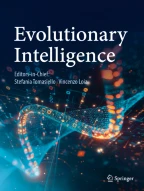Abstract
Band selection is being performed in hyperspectral imagery as a dimensionality reduction measure to enhance the efficiency of processing and analysis of the data. In this paper, a genetic algorithm based method is proposed that uses weighted combination of signal entropy and image spatial information in the objective function. The spatial dimension, that also includes huge redundancy, has been reduced using discrete wavelet transformation to make the method more time efficient without compromising the quality of the output. The performance of the method is evaluated by classifying the hyperspectral image with selected bands and measuring the accuracy of the classified output. The proposed method is also compared with other state of the art methods and found to be more efficient in selecting information rich bands in the hyperspectral data.
Similar content being viewed by others
Explore related subjects
Discover the latest articles, news and stories from top researchers in related subjects.References
Cao X, Han J, Yang S, Tao D, Jiao L (2016) Band selection and evaluation with spatial information. Int J Remote Sens 37(19):4501–4520. https://doi.org/10.1080/01431161.2016.1214301
Cortes C, Vapnik V (1995) Support-vector networks. Mach Learn 20(3):273
Cover TM, Thomas JA (2012) Elements of information theory, 2nd edn. Wiley. ISBN: 9788126541942, 9788126541942
Deepa P, Thilagavathi K (2015) Feature extraction of hyperspectral image using principal component analysis and folded-principal component analysis. In: 2015 2nd international conference on electronics and communication systems (ICECS). IEEE, pp 656–660
Duda RO, Hart PE, Stork DG (2000) Pattern classification. Wiley Interscience, New York
Ghorbanian A, Mohammadzadeh A (2018) An unsupervised feature extraction method based on band correlation clustering for hyperspectral image classification using limited training samples. Remote Sens Lett 9(10):982–991. https://doi.org/10.1080/2150704X.2018.1500723
Goldberg DE (1989) Genetic algorithms in search, optimization and machine learning. Addison-Wesley, New York
Gonzalez RC, Woods R (2007) Digital image processing, 2nd edn. Pearson Prentice Hall, Upper Saddle River
Hurtik P, Tomasiello S (2019) A review on the application of fuzzy transform in data and image compression. Soft Comput 23:12641–12653. https://doi.org/10.1007/s00500-019-03816-8
Hughes G (1968) On the mean accuracy of statistical pattern recognizers. IEEE Trans Inf Theory 14(1):55–63. https://doi.org/10.1109/TIT.1968.1054102
Jannati M, Zoej MJV (2015) Introducing genetic modification concept to optimize rational function models (RFMs) for georeferencing of satellite imagery. GIScience Remote Sens 52(4):510–525. https://doi.org/10.1080/15481603.2015.1052634
Li S, Wu H, Wan D, Zhu J (2011) An effective feature selection method for hyperspectral image classification based on genetic algorithm and support vector machine. Knowl Based Syst 24(1):40–48
Nakariyakul S, Casasent DP (2008) Improved forward floating selection algorithm for feature subset selection. In: Proceedings of international conference on wavelet analysis and pattern recognition. IEEE, Hong Kong
Paul A, Chaki N (2019) Dimensionality reduction of hyperspectral images using pooling. Pattern Recogn Image Anal 29(1):72–78. https://doi.org/10.1134/S1054661819010085
Paul A, Chaki N (2019) Dimensionality reduction using band correlation and variance measure from discrete wavelet transformed hyperspectral imagery. Ann Data Sci. https://doi.org/10.1007/s40745-019-00210-x
Paul A, Sahoo P, Chaki N (2020) Dimensionality reduction of hyperspectral images: a data-driven approach for band selection. In: Chaki R, Cortesi A, Saeed K, Chaki N (eds) Advanced computing and systems for security: advances in intelligent systems and computing, vol 1136. Springer, Singapore, pp 11–27. https://doi.org/10.1007/978-981-15-2930-6_2
Paul A, Bhoumik S, Chaki N (2020) SSNET: an improved deep hybrid network for hyperspectral image classification. Neural Comput Appl. https://doi.org/10.1007/s00521-020-05069-1
Paul A, Bhattacharya S, Dutta D, Sharma JR, Dadhwal VK (2015) Band selection in hyperspectral imagery using spatial cluster mean and genetic algorithms. GISci Remote Sens 52(6):644–661. https://doi.org/10.1080/15481603.2015.1075180
Sellami A, Farah M, Farah IR, Solaiman B (2018) Hyperspectral imagery semantic interpretation based on adaptive constrained band selection and knowledge extraction techniques. IEEE J Sel Top Appl Earth Obs Remote Sens 11(4):1337–1347
Serpico SB, Bruzzone L (2001) A new search algorithm for feature selection in hyperspectral remote sensing images. IEEE Trans Geosci Remote Sens 39(7):1360–1367
Shannon C (1948) A mathematical theory of communication. Bell Syst Tech J 27:379–423
Sun W, Du Q (2018) Graph-regularized fast and robust principal component Analysis for hyperspectral band selection. IEEE Trans Geosci Remote Sens 56(6):3185–3195
Su H, Cai Y, Du Q (2017) Firefly-algorithm-inspired framework with band selection and extreme learning machine for hyperspectral image classification. IEEE J Sel Top Appl Earth Obs Remote Sens 10(1):309–320
Sun K, Geng X, Ji L (2015) Exemplar component analysis: a fast band selection method for hyperspectral imagery. IEEE Geosci Remote Sens Lett 12(5):998–1002
Sun Y, Wang S, Liu Q, Hang R, Liu G (2017) Hypergraph embedding for spatial-spectral joint feature extraction in hyperspectral images. Remote Sens 9(5):506. https://doi.org/10.3390/rs9050506
Swain PH, Davis SM (1978) Remote sensing: the quantitative approach. McGraw-Hill, New York
Wang Q, Lin J, Yuan Y (2016) Salient band selection for hyperspectral image classification via manifold ranking. IEEE Trans Neural Netw Learn Syst 27(6):1279–1289
Yuan Y, Lin J, Wang Q (2016) Dual-clustering-based hyperspectral band selection by contextual analysis. IEEE Trans Geosci Remote Sens 54(3):1431–1445
Yuan Y, Zheng X, Lu X (2017) Discovering diverse subset for unsupervised hyperspectral band selection. IEEE Trans Image Process 26(1):51–64
Zhang W, Li X, Zhao L (2018) A fast hyperspectral feature selection method based on band correlation analysis. IEEE Geosci Remote Sens Lett 15(11):1750–1754
Author information
Authors and Affiliations
Corresponding author
Additional information
Publisher's Note
Springer Nature remains neutral with regard to jurisdictional claims in published maps and institutional affiliations.
Rights and permissions
About this article
Cite this article
Paul, A., Chaki, N. Dimensionality reduction of hyperspectral image using signal entropy and spatial information in genetic algorithm with discrete wavelet transformation. Evol. Intel. 14, 1793–1802 (2021). https://doi.org/10.1007/s12065-020-00460-2
Received:
Revised:
Accepted:
Published:
Issue Date:
DOI: https://doi.org/10.1007/s12065-020-00460-2
